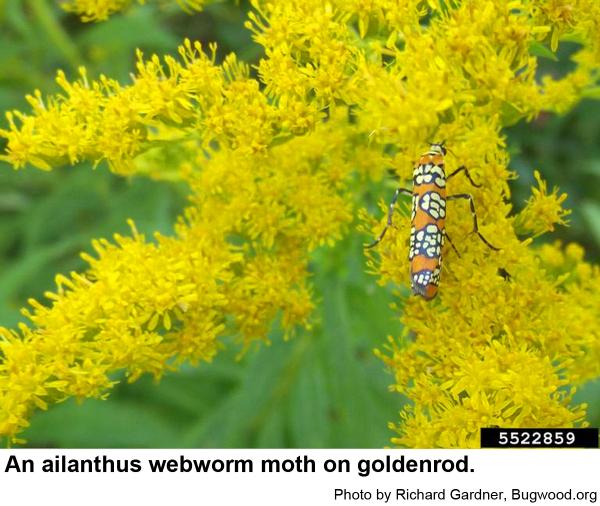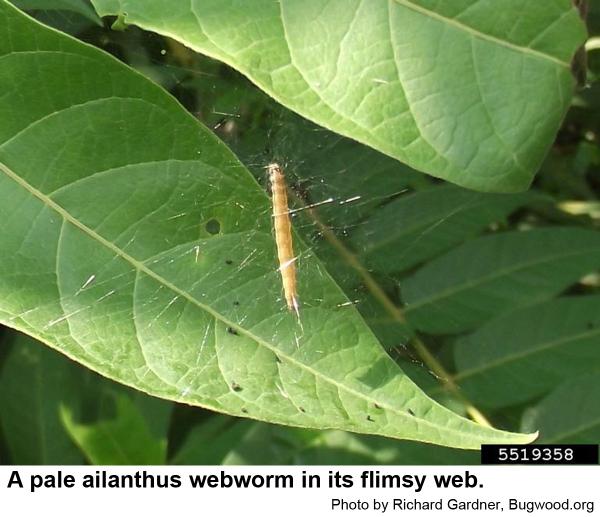Description and Biology
The ailanthus webworm, Atteva aurea, is the immature stage of an ermine moth, a small (1/2 inch), yellow-orange insect traversed by four blue-black bands marked with conspicuous white spots on the wings. The wings are held tight against the body when not in flight. Ailanthus webworms are slender, brown to almost black, and sometimes have four white dots on the top of each segment. The head is noticeably lighter in color and may also have white spots. Some thin white and olive-green stripes might show along each side of the abdomen. They spin a frail silken web on the leaves of ailanthus. Moths mate in the morning, and female moths lay their eggs in the webbing usually in the evening. When mature, webworms molt into pupae that are also suspended in the loose webs. The caterpillars remain in the web during the day, but leave it to feed at night. During the growing season, all stages may be found in a web. Development from egg to moth takes about a month, so we have several generations per year in North Carolina. Eggs overwinter and hatch in mid to late spring.
Host Plants
Although Ailanthus trees have a wonderful common name (tree of heaven), in North Carolina they seem to be more of a weed tree growing in vacant lots and in cracks in pavement. The ailanthus webworm also infests paradise tree, Simarouba glauca, as well as Simarouba amara. Adults are considered good pollinators as they visit many species of flowers during the daytime.
Residential Recommendations
The ailanthus webworm has not been reported to be resistant to insecticides. Most of the insecticides labeled for landscape use found in the garden sections of big box stores should give more than adequate control.
Other Resources
- Ailanthus webworm. 2018 (last edit). Anonymous. Wikipedia, The Free Encyclopedia.
- Ailanthus Webworm Moth (Atteva aurea). Frank, K. D. 2015. Chapter 6 In Ecology of Center City, Philadelphia. Fitler Square Press, pp.55-65
- Caterpillars That Feed on Trees and Shrubs. Frank, S. and S. Bambara. 2009. Entomology Insect Notes, NC State Extension Publications.
- Insect Profiles: Ailanthus Webworm. Reago A. and C. McClarren. 2017. Iron Tree Service.
- NC State Extension Plant Pathology Publications
- NC State Extension Horticultural Science Publications
- North Carolina Agricultural Chemicals Manual
For assistance with a specific problem, contact your local N.C. Cooperative Extension center.
This Factsheet has not been peer reviewed.
Publication date: March 11, 2019
Reviewed/Revised: Dec. 20, 2023
Recommendations for the use of agricultural chemicals are included in this publication as a convenience to the reader. The use of brand names and any mention or listing of commercial products or services in this publication does not imply endorsement by NC State University or N.C. A&T State University nor discrimination against similar products or services not mentioned. Individuals who use agricultural chemicals are responsible for ensuring that the intended use complies with current regulations and conforms to the product label. Be sure to obtain current information about usage regulations and examine a current product label before applying any chemical. For assistance, contact your local N.C. Cooperative Extension county center.
N.C. Cooperative Extension prohibits discrimination and harassment regardless of age, color, disability, family and marital status, gender identity, national origin, political beliefs, race, religion, sex (including pregnancy), sexual orientation and veteran status.







